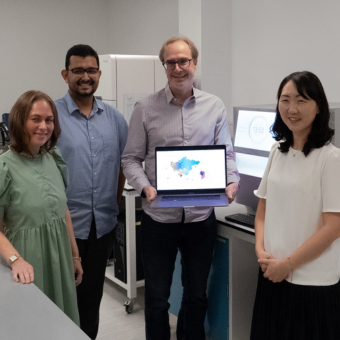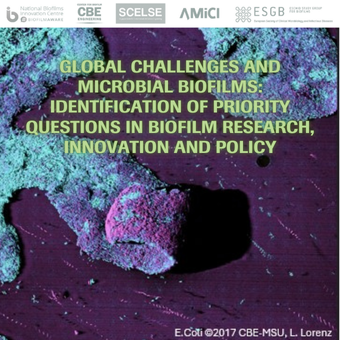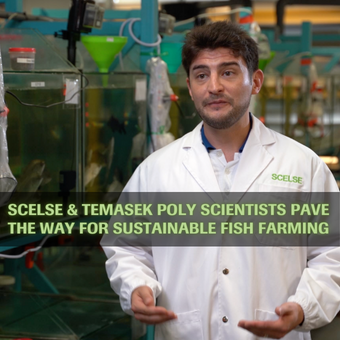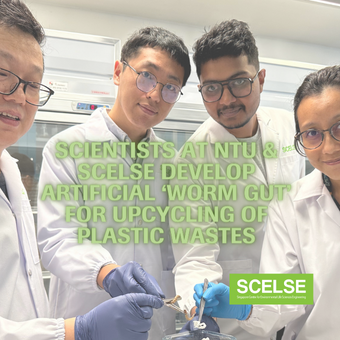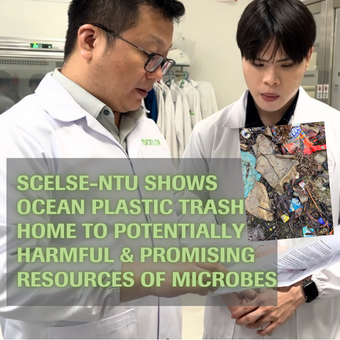Light-controlled bacteria paves the way towards clean water
In the face of increasing global demand for freshwater, the pressure is on for the water treatment industry to develop efficient water purification processes. Yet biofouling in water purification systems remains a challenge.
- In the Media
- 07 Jan 2019
SCELSE researchers engineer light-controlled bacteria to fight age-old problem of biofouling in water treatments for efficient solution to challenges of clean water access.
Biofouling occurs when a biofilm made up of colonies of microorganisms attaches to the surfaces in these systems, such as water purification membranes. This slows down the flow of water and the purification process.
Researchers from the Singapore Centre for Environmental Life Sciences Engineering (SCELSE), and School of Civil and Environmental Engineering (CEE) at Nanyang Technological University (NTU), Singapore, have engineered a special bacterial biofilm to combat this common problem of biofouling in water treatments.
“Biofouling is a ‘bad’ biofilm and the approach we have developed is like designing a ‘good’ and controllable biofilm to combat this ‘bad’ biofilm found on water purification membranes,” explained Associate Professor Cao Bin, who supervised the study and is the corresponding author of the paper published in Science Advances.
The researchers focused on biofouling that occurs on membranes in forward osmosis (FO) technology. FO technology is an increasingly popular application in water purification due to its lower consumption of energy as compared to other common treatment types, such as nanofiltration and reverse osmosis. “Our results could pave the way to a more sustainable and efficient membrane water purification system to address the grand challenge of clean water access,” Assoc. Prof. Cao added.
A dual approach to targeting biofouling
To first ensure that their engineered biofilm would itself not grow too thickly and contribute to the biofouling it was meant to counter, the researchers found a way to modulate its development. They introduced synthetic gene circuits to an Escherichia coli strain to make it sensitive to near-infrared light and blue light, thereby providing control over the growth and dispersal of its biofilm. Controlling E. coli growth also limits its potential to hinder water flow through the membranes and slow down purification processes.
The novel biofilm was targeted at mitigating biofouling caused by other bacteria present in the water treatment systems. To do so, the researchers introduced a gene that enabled the E. coli strain to produce QQ (quorum quenching) enzymes to disrupt communication among other bacteria encountered on the membrane. This cell-to-cell communication plays an important role in biofilm formation, thereby disrupting this communication process reduces the buildup of bacteria into a biofilm and biofouling.
Controlling the performance of bacteria with light
The researchers used near-infrared light to facilitate the formation of their special biofilm to achieve sufficient QQ activity. They applied it purposefully to a FO membrane and exposed it to Pantoea stewartii, an isolate from wastewater. For comparison, the researchers also set up a control biofilm with light-responsive properties but with no QQ enzyme-producing capabilities, and a separate biofilm formed by P. stewartii solely.
The QQ enzyme-producing biofilm had an inhibitory effect on biofilm formation by other bacteria, as it was able to do so with P. stewartii. In contrast, the QQ-negative control biofilm did not interfere with the biofilm formed by P. stewartii.
Additionally, when subjected to blue light irradiation, the novel light-sensitive QQ E. coli biofilm detached from the membrane surface, taking the foulant bacteria, including dead bacteria, away from the surface, making the purification process more efficient.
These findings suggest that the formation and detachment of the engineered QQ biofilm on FO membranes and thus, the efficiency of the water purification process can be controlled by light.
The researchers’ novel approach to design a controllable biofilm is not limited for use in water purification, but may also facilitate processes in biochemical and biotechnological industries, such as the production of fine chemicals and pharmaceuticals.
“This work provides an example of how we can translate biofilm biology into novel biotechnological approaches for environmental applications,” said Assoc. Prof. Cao.
Co-authors of the paper include Manisha Mukherjee, Yidan Hu, Chuan Hao Tan and Scott A. Rice.
This research was supported by funding from the Ministry of Education (MOE) Singapore, the National Research Foundation, and Singapore Centre for Environmental Life Sciences Engineering, and Nanyang Technological University, Singapore
Note to Editors:
The study, “Engineering a light responsive, quorum quenching biofilm to mitigate biofouling on water purification membranes” is published in Science Advances journal, Vol. 4, Issue 12, on 7 December 2018. DOI: 10.1126/sciadv.aau1459
About Singapore Centre for Environmental Life Sciences Engineering (SCELSE)
The Singapore Centre for Environmental Life Sciences Engineering (SCELSE) is a unique interdisciplinary Research Centre of Excellence (RCE), funded by National Research Foundation, Singapore Ministry of Education, Nanyang Technological University and National University of Singapore. Hosted by NTU in partnership with NUS, SCELSE is linking new insights from the life sciences with expertise from the emerging technologies in engineering and natural sciences to understand, harness and control microbial biofilm communities and microbiomes.
For more information on SCELSE, please visit www.scelse.sg. For further updates on SCELSE, follow us on Twitter and Facebook.
About School of Civil and Environmental Engineering (CEE)
The School of Civil and Environmental Engineering (CEE) was established in 1982 as the School of Civil and Structural Engineering. Renamed in 2002, the School’s curriculum and programmes reflects the vision of being a leading school in Sustainable Built Environments. CEE plays an integral role in spearheading tertiary education, advancing research innovations and providing professional services in a number of key disciplines in Civil and Environmental Engineering and Maritime Studies fields, with the objective of contributing to the technological and economic advancement of Singapore and beyond. The School’s mission in research is to achieve excellence by providing a conducive and intellectually stimulating environment to enable high quality work in strategic directions that are of significant impact to industry, science and technology.
For more information, please visit https://www.cee.ntu.edu.sg and https://www.facebook.com/CEE.NTUsg/.
MEDIA CONTACT:
Dr Sharon Longford, Senior Assistant Director
Science Communications, SCELSE
Email: sharonlongford@ntu.edu.sg
(Ms) Linda Koh, Manager
Administration Unit, School of Civil and Environmental Engineering, NTU
Email: lindakoh@ntu.edu.sg
